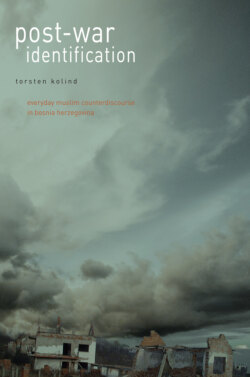Читать книгу Post-War Identification - Torsten Kolind - Страница 10
Symbolically
ОглавлениеThe public sphere in Stolac was dominated by nationalist-minded Croats symbolically as well as institutionally. The public sphere was filled with nationalist symbols of all sorts. Again, let me offer some examples. Today the central mosque in town (Čaršija mosque) has been rebuilt; but when I did fieldwork, the whole area – where the mosque and all the old buildings connected to the marketplace area surrounding the mosque had been before – was laid out as a parking lot, and on one side there were three flags: the flag of Herceg-Bosna, and two flags with the Herzegovinian Croats’ newly designed version of the coat of arms of Stolac. A big wooden cross had been erected outside the municipal office. Crosses were used by the Croats as territorial markers in various places in Herzegovina. On the outskirts of villages or areas ruled by Croats, one often saw two/three-meter-tall concrete crosses painted white. Inside the medical centre, there was a huge poster with a picture of the former Croatian president Franjo Tuđman, who supported the struggle of the Herzegovinian Croats. Inside all the public buildings I entered, I saw the Šahovnica (a framed checkerboard emblem composed of white and red squares, the Croatian coat of arms with strongly nationalist and at times fascist undertones) the size of a normal sheet, and several places also a poster of Franjo Tuđman. On the top of Stari Grad (Pasha Rizvanbegovic fortress, an old fortress and a cultural monument), there was a big Croatian flag that could be seen from almost any part of town. Nationalist Croat graffiti was abundant, though a lot of it originated from the time of the war. For instance, on entering Stolac one sees the sentence Dobro došli U Stolac (Welcome to Stolac) painted on a house, with the ‘U’ painted in a way that symbolises Ustashe.9 However, the graffiti is rather faded. Streets and town sites have been given new names, which are all part of a Croatian nationalist discourse. Many Bosnian Croat cars had a BiH (Bosnia Herzegovina) sticker on the back of the car, but the letters were printed on a red and white checked background, the Croatian national symbol. Leading up to the general election in November 2000, many of the election posters of the Herzegovinian Croats featured fierce nationalist rhetoric. In short, Stolac was ruled by nationalist-minded Herzegovinian Croats. On the institutional level and on the public symbolic level, the Muslims have no influence. In all these arenas ethnic discrimination and nationalist symbolism prevails.
I have found it necessary to begin with this short prologue summarising the war in Herzegovina and Stolac in particular, outlining the return of the Muslims to Stolac, and describing the incessant dominance of nationalist ideology in the public sphere. These matters are rather complicated, and I refer to episodes and periods throughout the book. The other main function of the prologue is to describe a town where nationalist thinking had come to be totally dominant because of both war aims and post-war policy. My informants’ counterdiscourse, which is the focus of the book, has to be understood on the background of this dominance.
1 By March 1991 Tuđman and Milošović had already met to discuss the partition of Bosnia Herzegovina between them, and on May 1992 Tuđman sponsored talks between Mate Boban, the leader of the Bosnian Croats’ strongly nationalistic and heavily influential political party HDZ, and Radovan Karadžić, leader of the Bosnian Serbs, at which time they considered a potential division of Bosnian territory (Bennet 1995: 200, Glenny 1996: 193-4).
2 The figure 200,000 is from UN sources, the figure 100,000 is from a recent research project at the Reserach and Documentation Center Sarajevo.
3 See OHR’s HumanRights report 28, May 1998.
4 I do not know the reason for the sabotage, but see Bax (1997) for similar actions elsewhere in Herzegovina, where Partisan memorials were interpreted by local Croats as symbols of Serbian oppression.
5 Serbian forces in Bosnia Herzegovina consisted of Bosnian Serbs as well as part of the former JNA.
6 Several Muslims I spoke to saw the Croatian conquest of Stolac as part of a deal between the Serbian and Croatian forces about sharing the territory of Bosnia Herzegovina between them. As an example of such a deal people recall how in this period of Croatian/Muslim control of Stolac, Croatian refugees from Central Bosnia were driven to Croatian territory south of Stolac through Serb-controlled territory, that is, with the approval of the Serbs (see Glenny 1996: 196-8for further elements of the political games influencing life in Stolac).
7 Though it is important to account for the many local strategies and motives in the war (see e.g. Bax 2000a, 2000b) when outlining episodes in the war in Southern Herzegovina, one also has to acknowledge that the expulsion of the Muslims from Stolac and other towns was orchestrated from above and formed part of a general Croatian attempt to annex and ethnically cleanse parts of Bosnia Herzegovina, see for instance Cigar (1995) and Glenny (1996).
8 See document Crimes in Stolac Municipality for a thorough statement of the destruction of historic monuments in Stolac. The document is also on the Internet: http://www.haverford.edu/relg/sells/stolac/CrimesSt.pdf
9 Ustashe is closely connected to violent Croat nationalist and fascist policy.
